Chevy Tahoe Dashboard Warning Lights
Detailed below are the dashboard warning lights for the Chevrolet Tahoe. Each Chevy Tahoe warning light symbol is displayed along with its meaning and action to take based on the manufacturer’s guidelines. Some of the symbols below may not apply to older versions of the Chevy Tahoe.
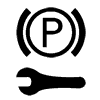 Service Parking Brake
Service Parking Brake
The Chevy Tahoe service parking brake warning light comprises of a amber park symbol and wrench. This light comes on due to a fault being detected with the electric parking brake and where the system requires servicing. There may also be parking brake-related messages in the Driver Information Center (DIC). When the service parking brake light is on, it may not be possible to secure the vehicle when parked. Have the system checked as soon as possible.
If the red electric parking brake warning light flashes ![]() or
or ![]() it means there’s a fault with the system and requires servicing.
it means there’s a fault with the system and requires servicing.
 Airbag
Airbag
The Chevy Tahoe airbag warning light should illuminate in red for several seconds when the vehicle is started, then go off. If the airbag light fails to come on at all, or stays on constantly, the system requires servicing. Airbag faults often relate to loose connection under the front seats, airbag sensor, passenger occupancy sensor or an object being lodged in a belt buckle.
 Battery
Battery
The Chevy Tahoe battery warning light should illuminate in red when the ignition is switched on to show the warning light is working. It should then go out when the engine has started. If it stays on, comes on while driving or flashes, it means there’s a fault with the electrical charging system. The most common fault is a failing alternator that is no longer properly charging the battery. Wiring / connections or an ageing battery can also cause issues.
If driving, the engine may lose power when the battery is exhausted of power. To extend the ability to drive, switch off any electrical equipment that’s not essential.
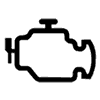 Check Engine
Check Engine
With the ignition switch in service mode, the Chevy Tahoe check engine warning light should come on to show it’s working. If it stays on, or comes on while driving it means there’s a fault with the vehicle’s emissions system. As soon as a fault is detected, the on-board diagnostic system sends a fault code to the ECU.
Fault codes should be read with diagnostic equipment. You can continue driving with the check engine light on, but have the fault diagnosed before it becomes worse. Continued driving may see a drop in fuel efficiency and the engine may not run as smoothly.
If the check engine warning light flashes, avoid putting the engine under high loads or speed. This may indicate a misfire in the engine and can damage the catalytic converter. Stopping the vehicle and switching off the engine for at least 10 seconds may turn off the check engine light. If the light continues to flash, have diagnosis as soon as possible. There are many potential faults that cause the check engine light to come on. Common check engine faults include:
- Spark plugs
- Mass airflow sensor
- Oxygen sensor
- Faulty / loose gas cap
- Catalytic converter issues
- Poor fuel quality
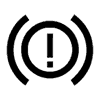 Brake
Brake
The red brake warning light is either displayed as a symbol or displays as text ‘![]() ‘. The illumination of the brake warning light indicates a brake system malfunction. If driving, you may notice that the brake pedal is harder to operate than normal.
‘. The illumination of the brake warning light indicates a brake system malfunction. If driving, you may notice that the brake pedal is harder to operate than normal.
This is because the brake booster is not providing assistance to the brake pedal. It’s likely that it’ll take you longer to stop the vehicle. When the brake warning light comes on, the vehicle may operate on reduced power as a safety precaution. It’s advised that you have the vehicle towed and avoid driving until that fault has been rectified. Check brake fluid levels and for signs of brake fluid leaks.
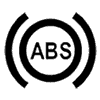 ABS
ABS
As a bulb check, the ABS light should come on briefly when the vehicle is switch on, then go off. If the ABS warning light comes on while driving, stop when safe to do so and switch off the engine. Restarting the engine will reset the ABS system.
If the ABS warning light remains on (a chime may also sound), it means there’s a fault with the Chevy Tahoe anti-lock braking system. If it’s only the ABS light, it means there’s a fault with ABS but the brake system will work as normal. The usual cause of fault is with one of the wheel speed sensors. If the ABS and BRAKE lights both come on, it means there’s a fault with the ABS system and brake system.
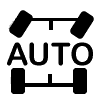 Four Wheel Drive
Four Wheel Drive
The Chevy Tahoe four -wheel-drive light (showing auto mode) displays what mode the vehicle is in. The
light will show each mode: 2WD, 4HI, AUTO (all transfer cases); 4LOW and N (two-speed transfer case only). The light flashes when a shift id in progress. If the light turns amber, it means a fault has been detected.
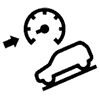 Hill Descent
Hill Descent
The Chevy Tahoe Hill Descent Control (HDC) sets and maintains vehicle speed while driving down steep grades in a forward or reverse gear. The HDC dash light comes on when the system is ready to use and flashes when the system is active.
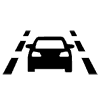 Lane Keep Assist
Lane Keep Assist
The Chevy Tahoe Lane Keep Assist system (LKA) helps to avoid collisions by alerting the driver of an unintended lane departure. If the LKA light is white, the system is on but not ready to assist. If the light is green, LKA is ready to assist. If you are receiving alerts that LKA is not working correctly, ensure the camera view on the front windshield is free from dirt / snow etc.
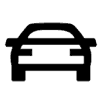 Vehicle Ahead
Vehicle Ahead
The Chevy Tahoe Vehicle Ahead indicator, or Forward Collision Alert (FCA) helps to reduce front-end crashes by alerting the driver with a red flashing warning alert and pulses the driver seat. The light comes on in amber when following a vehicle too closely. When a vehicle is detected ahead and you’re at a safe following distance, the warning light illuminates in green.
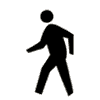 Pedestrian Ahead
Pedestrian Ahead
As with FCA, the Chevy Tahoe Pedestrian Ahead indicator, provides the driver with alerts when the system detects a pedestrian. This system includes Intelligent Brake Assist (IBA), and the Automatic Emergency Braking (AEB) system may also respond to pedestrians.
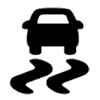 Electronic Stability Control
Electronic Stability Control
Electronic Stability Control (ESC) is a vehicle stability system that helps to improve tire traction and helps to correct understeer and oversteer. The warning light flashes when the system is operating. If the warning light remains constantly lit, it means there’s a fault. ESC uses ABS wheel speed sensors and is often the cause of fault.
As part of ESC, traction control helps to provide better traction to the tires. It’s often best to leave traction control on, but if your vehicle is finding it difficult to exit slippery conditions such as snow or mud, turning off traction control may benefit. The traction control off warning light ![]() will illuminate.
will illuminate.
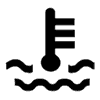 Engine Coolant Temperature
Engine Coolant Temperature
This red engine coolant temperature warning light stays on meaning the engine has overheated. The warning light may come on along with a warning message. If steam is coming from the engine compartment, it’s advised to switch off the engine and allow it to cool before opening the hood.
If there is no steam, leave the engine running and check to see if the engine cooling fan(s) are running. If the engine is overheating, the
fans should be running. If they are not, do not continue to run the engine. Additionally, if there’s a leak in the cooling system, do not continue to run the engine.
If the engine is running hot, switching off the air conditioning and switching on the heating can help cool it. An engine coolant gauge is in addition to the warning light. If one says the engine is overheating, but the other says normal temperature and there’s no signs of overheating, it’s likely fault with a sensor. Individual, or multipurpose sensors are often used to control the warning light and gauge.
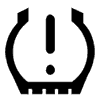 Tire Pressure
Tire Pressure
For versions of the Chevy Tahoe that has a Tire Pressure Monitoring System (TPMS), this light illuminates when one or more tires is detected underinflated. If the warning light flashes then stays on, it means the TPMS has a fault. Each tire must have a pressure sensor mounted inside for operation.
If a tire is fitted without a sensor (the spare has no sensor) the TPMS will not operate correctly. Another common reason for the tire pressure warning light is that the TPMS sensor matching process was not done or not completed successfully after rotating the tires, or that replacement tires or wheels do not match
the original equipment tires or wheels.
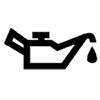 Oil Pressure
Oil Pressure
If the Chevy Tahoe oil pressure warning light comes on while driving, pull off the highway as soon as possible and switch off the engine. This may indicate low oil levels. Check oil levels and add oil if required. If the oil light remains on after adding oil, it indicates low oil pressure and means that oil is not flowing through the engine properly. Do not continue driving as this will damage the engine.
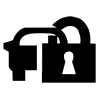 Security
Security
The Chevy Tahoe security light should come on briefly as the engine is started and if the system is working normally, the warning light turns off shortly after. If the light stays on and the engine does not start, there could be a problem with the theft-deterrent system, or an issue with the programmed key. If the engine does not start, try another key or try placing the remote key in the backup location.
Driver Modes
Depending on your version of Chevy Tohoe, there are several driver modes that include:
 Sports Mode
Sports Mode
The Chevy Tahoe sports mode select symbol.
 Snow Mode
Snow Mode
The Chevy Tahoe snow mode select symbol.
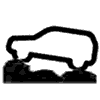 Terrain Mode
Terrain Mode
The Chevy Tahoe terrain mode select symbol.
 Off-Road Mode
Off-Road Mode
The Chevy Tahoe off-road mode select symbol.
 Tow/Haul Mode
Tow/Haul Mode
The Chevy Tahoe tow/haul mode select symbol.
Air Suspension Symbols
The various symbols associated with the Chevy Tahoe air suspension include:
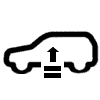 Maximum Ground Clearance
Maximum Ground Clearance
This light comes on when the Chevy Tahoe air suspension is raised to maximum ground clearance height.
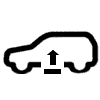 Increased Ground Clearance
Increased Ground Clearance
This light comes on when the Chevy Tahoe air suspension is raised to increased ground clearance
height. It will flash green and give an alert to indicate that the vehicle is changing to a higher ride height.
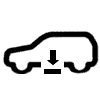 Lowered Air Suspension
Lowered Air Suspension
This light comes on when the Chevy Tahoe air suspension is lowered for easy entry and exit from the vehicle.
It will flash green and give an alert to indicate that the vehicle is changing to a lower ride height.
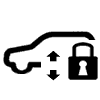 Air Suspension Service Mode
Air Suspension Service Mode
This light comes on when the Chevy Tahoe air suspension is in Service Mode or Alignment Mode.
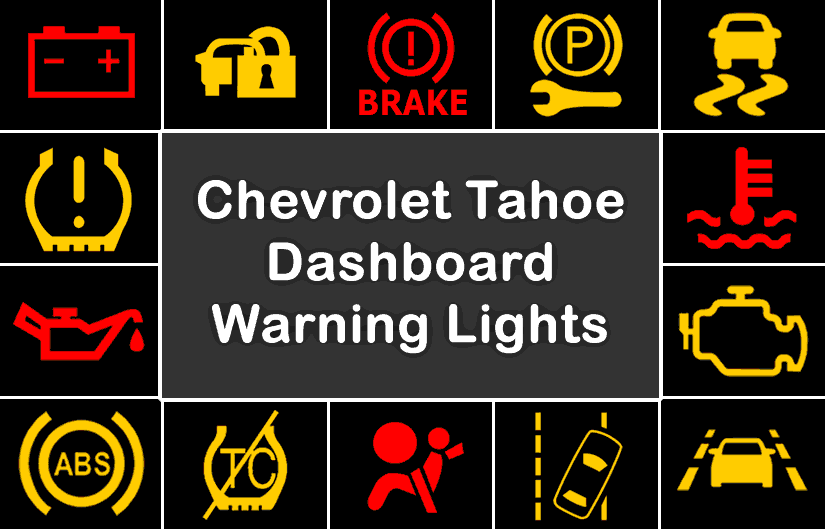
On either side of the DIC in my 2017 Chevy Suburban are two tiny blue lights. Nomination as to what there are in the owners manual, and a call to GM telephone assistance proved futile too. Any idea what these lights are for???